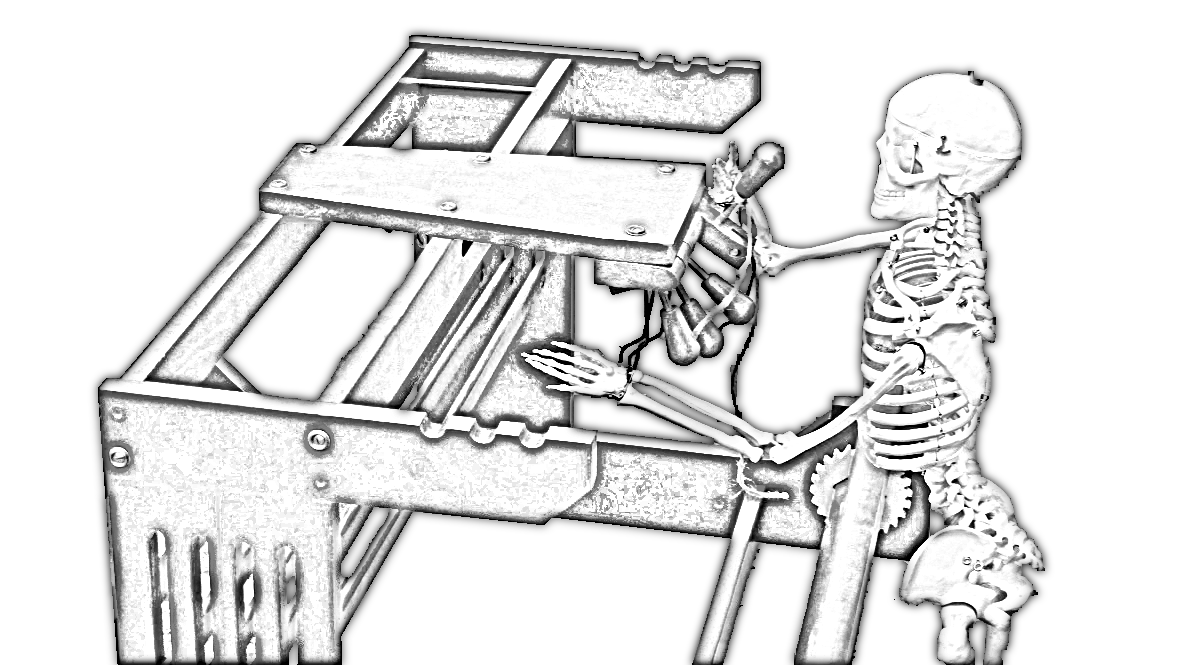

CREATING LIFE'S FABRIC
CREATING LIFE'S FABRIC
After Autonomy Forte I bought a second loom; a more manageable size this time.
I took it apart and painted it blood red. From a fingertip I pricked a drop of blood to find the right colour, but in the end I chose a more substantial red than this physical one.
Why another loom?
For the same reason as with the first, and ..
Na Autonomy Forte kocht ik een tweede weefgetouw; een handzamer formaat deze keer. Ik haalde het uit elkaar en verfde het bloedrood.
Uit een vingertop prikte ik een druppel om de kleur te zoeken maar uiteindelijk koos ik voor een wezenlijker rood dan dit fysieke.
Waarom opnieuw het weefgetouw?
Om dezelfde reden als bij het eerste, en ..
‘There she weaves by night and day
A magic web with colors gay
She has heard a whisper say
A curse is on her if she stay
To look down to Camelot…
And moving thro’ a mirror clear
That hangs before her all the year
Shadows of’ the world appear,
There she sees the highway near
Winding down to Camelot..’
Uit: ‘The Lady of Shalott’
Tennyson, 1832
‘There she weaves by night and day
A magic web with colors gay
She has heard a whisper say
A curse is on her if she stay
To look down to Camelot…
And moving thro’ a mirror clear
That hangs before her all the year
Shadows of’ the world appear,
There she sees the highway near
Winding down to Camelot..’
Uit: ‘The Lady of Shalott’
Tennyson, 1832
..I read.
At the time, I spent long afternoons in the Royal Library in The Hague reading a non-lendable book; “The symbolism of vanitas in the arts, literature and music” (Liana DeGirolami Cheney, 1989)
In a section dealing with the symbolism of mirrors I found a story about a woman (The Lady of Shalott) in a tower room on an island. She wove. And although the text went deeper into the meaning of the poem, I was more gripped by a line about the craft;
“This work is unique in that it appears to be the only version of the scene in which the mirror is correctly used – that is, in a position behind the loom to reflect the pattern which is being woven, as traditionally the weaver works from the back and cannot see the pattern woven on the front of the tapestry without the aid of a mirror.”
Was that so?
It was. In the technique of visual weaving, with which tapestries are made, for example, a mirror can be very useful to check the weaving pattern appearing on the front while working on the back.
Until it is finished, the maker works on the back, in a jumble of color and thread.
In a sense, you are working without seeing what you are doing, interacting with the loom.
Creating something. Being there. And by doing something become another.
There are edifying texts about our life-garment being turned at the Gates of Heaven, and the revelation of the thus far hidden golden thread of the Divine at that particular moment.
I can’t say I necessarily view life as an assignment, or a divine gift but it is surely hopeful and purifying on its own to suspect gold at the place where you are wrestling with threads of mud, or simply to coincide with what you are embarking upon, melting in flow with, seeking, or just attempting to bring to an magnificent ending.
..I read.
At the time, I spent long afternoons in the Royal Library in The Hague reading a non-lendable book; “The symbolism of vanitas in the arts, literature and music” (Liana DeGirolami Cheney, 1989)
In a section dealing with the symbolism of mirrors I found a story about a woman (The Lady of Shalott) in a tower room on an island. She wove. And although the text went deeper into the meaning of the poem, I was more gripped by a line about the craft;
“This work is unique in that it appears to be the only version of the scene in which the mirror is correctly used – that is, in a position behind the loom to reflect the pattern which is being woven, as traditionally the weaver works from the back and cannot see the pattern woven on the front of the tapestry without the aid of a mirror.”
Was that so?
It was. In the technique of visual weaving, with which tapestries are made, for example, a mirror can be very useful to check the weaving pattern appearing on the front while working on the back.
Until it is finished, the maker works on the back, in a jumble of color and thread.
In a sense, you are working without seeing what you are doing, interacting with the loom.
Creating something. Being there. And by doing something become another.
There are edifying texts about our life-garment being turned at the Gates of Heaven, and the revelation of the thus far hidden golden thread of the Divine at that particular moment.
I can’t say I necessarily view life as an assignment, or a divine gift but it is surely hopeful and purifying on its own to suspect gold at the place where you are wrestling with threads of mud, or simply to coincide with what you are embarking upon, melting in flow with, seeking, or just attempting to bring to an magnificent ending.